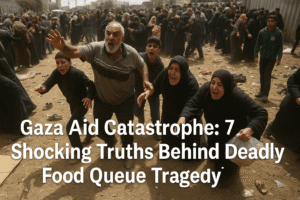Gaza Aid Catastrophe: 7 Shocking Truths Behind Deadly Food Queue Tragedy
At least 27 Palestinians were gunned down while waiting for food in Rafah, Gaza – victims of Israeli forces who opened fire near a U.S.-backed aid distribution point. The IDF claims people “posed a threat,” but survivors describe a scene of starvation-fueled chaos. This marks over 100 Palestinian deaths at these sites in just eight days, exposing a lethal contradiction: humanitarian zones transformed into killing fields. Israel’s replacement of UN aid channels with its controlled “Gaza Humanitarian Foundation” (GHF) has drawn widespread condemnation for militarizing food access.
As famine tightens its grip, desperate civilians now risk death simply seeking sustenance. UN chief Guterres demands an independent probe, declaring it “unacceptable that Palestinians risk their lives for food.” Behind the numbers lie shattered families burying children who sought flour – where survival itself becomes a perceived threat.

Gaza Aid Catastrophe: 7 Shocking Truths Behind Deadly Food Queue Tragedy
Before dawn on Tuesday, crowds gathered near a U.S.-backed aid distribution site in Rafah, Gaza. According to the Hamas-run health ministry, 27 Palestinians were killed by Israeli fire, with over 90 injured. The IDF stated its troops shot at individuals who “posed a threat” after deviating from designated routes. Survivors describe a scene of chaos as people scrambled for food amid Gaza’s man-made famine.
A Pattern of Bloodshed
This is not an isolated incident:
- 102 Palestinians have died near aid sites in just 8 days since these centers opened.
- On Sunday, 31 were killed near the same distribution point.
- Monday saw 3 more deaths.
The Gaza media office calls these centers “mass death traps,” revealing a grim paradox: Humanitarian zones are now among the deadliest places in Gaza.
Why Aid Distribution Turned Lethal
The core tension lies in Israel’s new aid framework:
- The GHF System: Israel replaced UN agencies with the Gaza Humanitarian Foundation (GHF), a private group using U.S. security contractors.
- Contested Control: Israel claims Hamas diverts aid; Hamas demands neutral UN distribution. The GHF model concentrates crowds at militarized “secure sites.”
- Desperation vs. Security: Starving civilians breach IDF-enforced routes; soldiers perceive movements as threats. The result? Warning shots into crowds.
Eyewitness Reality vs. Official Narratives
At Nasser Hospital, nurse Mohammed Saqr received victims: “Three children and two women… their wounds tell of panic, not combat.” Meanwhile, the IDF insists troops “did not fire at civilians near the distribution site.” The disconnect highlights why UN Secretary-General Guterres demands an independent investigation: “It’s unacceptable that Palestinians risk their lives for food.”
The Bigger Picture: A Failed Aid Model
The GHF experiment exposes critical flaws:
- Forced Relocation: Civilians must journey through active conflict zones to reach food.
- Rejected Principles: Major aid groups boycott GHF, calling it a violation of humanitarian neutrality.
- Famine as Weapon: Israel’s siege has left 500,000+ facing starvation, turning aid queues into tinderboxes.
Ceasefire Stalemate
This bloodshed unfolds amid frozen negotiations:
- Hamas seeks amendments to Israel’s accepted ceasefire proposal.
- Israel demands hostage returns before substantive talks.
As politics stall, civilians pay with their lives – not from bombs, but breadlines.
The Human Cost
- Mothers burying children who sought flour.
- Field hospitals overwhelmed with shrapnel wounds from “warning shots.”
- A population where survival instinct is now conflated with threat.
You must be logged in to post a comment.